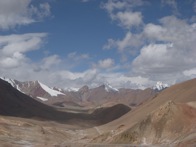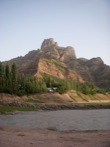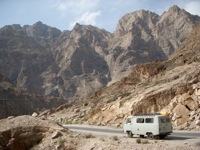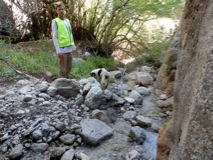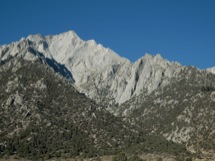
I am interested in how mountains evolve over time. Tectonics, sedimentation, climate, and the interactions between them all play into the evolution of mountain ranges, so I get to dabble in several disciplines.
My PhD work with Cliff Riebe is focused on the geomorphic end of this spectrum, delving into watershed-scale erosion, sediment transport, and sediment source on a landscape. The basic tenet is this: If you were to stand on a stream bank and look at all the sediment in the stream, where did that sediment come from? How did it get there? What can the stream sediment tell us about the geomorphic processes shaping the landscape?
To this end, I am employing a combination of apatite (U-Th)/He dating, cosmogenic nuclides, and numerical modeling to address how sediment source and erosion vary across watersheds. Currently, this work is focused at field sites in the Sierra Nevada, with several additional sites in the wings pending preliminary results.
My MS work focused on Cenozoic tectonics Pamir Mountains of Tajikistan, and was conducted under the supervision of Barbara Carrapa.
The Pamir lie northwest of the Karakorum and Hindu Kush in Central Asia, and are part of the larger Himalayan system of high topography created by the collision of India and Asia. The Pamir are poorly understood, and present a potentially unique tectonic setting wherein continental crust and lithosphere are being subducted deep into the mantle. My work there employed detrital zircon U-Pb geochronology and 40/39Ar thermochronology on white micas to estimate the timing of uplift in the western Pamir, to evaluate potential terrane correlations with Tibet, and to hypothesize about the tectonic evolution of the Pamir in the Cenozoic.
More info can be found in the resulting publication:
Lukens, C.E. Carrapa, B., Singer, B. S., & Gehrels, G.,2012, Miocene Exhumation of the Pamir revealed by detrital geo-thermochronology of Tajik rivers: Tectonics, 31, TC2014.
As an undergraduate, my primary focus was on sedimentology. Under Paul Myrow at Colorado College, I completed a thesis examining density-driven flow deposits in Pennsylvanian rocks in central Colorado. The results of that work can be found here:
Myrow, P.M., Lukens, C., Lamb, M.P., Houck, K., and Strauss, J, 2008. Transgressive prodelta deposits, Pennsylvanian Minturn formation, Colorado. Jour. Sed. Res., 78, 512-528.
Lamb, M.P., Myrow, P.M., Lukens, C., Houck, K., and Strauss, J, 2008. Deposits of wave influenced turbidity currents: Pennsylvanian Minturn formation, Colorado. Jour. Sed. Res., 78; 480-498.
